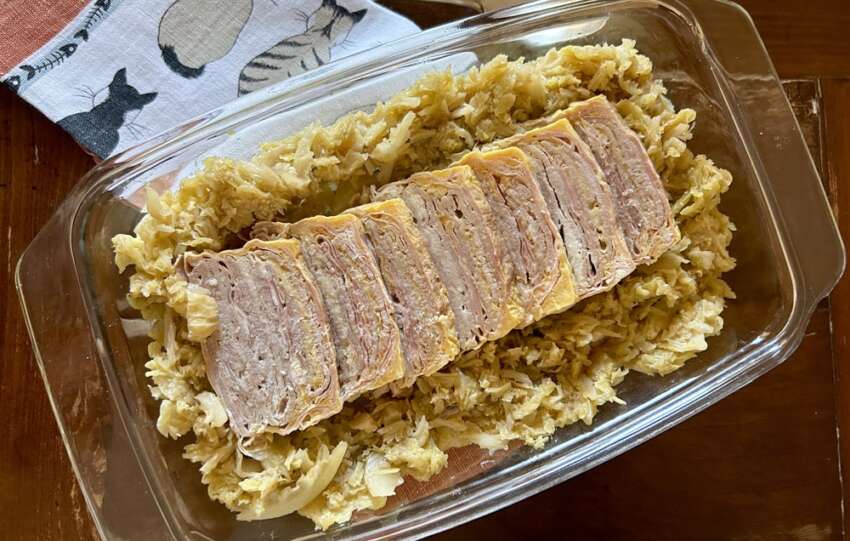The recipe for potato flan, in this case, stuffed with cheese and mortadella, makes me think back to the months I spent in Bonn, Germany. And to how much the kitchen, understood as a physical place, is, at least for me, an important space.
I have lived in different places and houses for longer and shorter periods.
And of each experience, I remember the kitchen.
Probably because of the imprint in my memory of the one I knew as a child.
It was bright, full of women, talks, and food. The kitchen was the center of my world for so long.
Of course, I had no idea how relevant that space would be in evaluating an experience until I lived in other kitchens.

An experience in Bonn
I went while I was attending my master’s program after graduation.
An Italian and a British colleague left with me. The other classmates chose Madrid, Paris, or London.
I followed my intuition. There was the allure of a city I didn’t know, the reassurance that classes would be in English, and the chance to work in a prestigious foundation.
It was a happy choice. In the morning, I went to the University for my course. Then I moved to the Adenauer Foundation for my research work. In the late afternoon, I would return to the campus.
The rectangle-shaped building was formed by blocks consisting of several floors.
Each level was a micro-world with dozens of tiny bedrooms and a large shared kitchen.
The students I met came from all parts of Europe but, above all, from the Northern countries, and the common language was English.
My kitchen at the campus
I was in Bonn for a few days when Italian residents of the campus intercepted me. Every night they had dinner together in an Italian pizzeria to speak always of Italy.
After two dinners, I felt some sadness.
I was there to have a good experience, not to regret something that, moreover, I did not miss. Attracted by the warmth and liveliness of the kitchen on my floor, I decided to prepare and eat dinner there. And from the first time, I never ate alone, not even one night.
The kitchen was cleverly designed. It was a large room with an entirely windowed wall, two long tables to sit at to eat, many stoves, and small pantries.
There was always someone in the kitchen.
My colleagues studied, cooked, chatted, and ate there, day and night.
On that occasion, I saw the unifying power of the shared kitchen table. While someone prepared, one tasted, and another shared bread with those who had forgotten to buy it.
That was how I went about my moment of glory.
If you are thinking of a pasta dish, you are wrong.
The cheese was the staple diet of many of my colleagues from breakfast on, so you can easily understand why my potato flan filled with cheese was a crazy success.

Filled potato flan
Flan or sformato was typical of the cold season, besides a way to recycle leftover mashed potatoes. A little like potato and ragù pie, very similar to flans.
Nonna would mix mashed potatoes with egg and Parmesan cheese.
Then she placed the dough in the baking pan by pressing with her fingertips, forming edges to hold the filling. Sometimes made with a mix of leftovers, sometimes of mixed cheeses.
And on the happiest occasions, the filling’s potato flan was cheese-mortadella-cheese.
As grandmother used to do, set aside some of the potato dough to roll it out and use it as a kind of lid.
It is a convivial recipe. Each time there is some hurried puts the bite in his mouth too soon, and then complains it burns while others laugh. And it is a comfort food dish with that stringy cheese that puts one in a good mood and the smell of Bologna bologna that tickles the nose.
Buona cucina, Monica
If you love potatoes as much as I do, take a look at the recipes for the vegetarian artichoke stew with potatoes and the potato, rice, and porcini casserole (but you can use any mushrooms you like).
Keep in Touch
- To receive unpublished recipes, tips, and food stories, sign up for the Tortellini&CO newsletter.
- Follow me onInstagram, Pinterest and Facebook.

Potato flan filled with cheese and mortadella
serves 4
List of the Ingredients
500 g boiled and mashed potatoes
60 g grated Parmesan cheese + that for the surface
120 g thinly sliced mortadella
100 g thinly sliced cheese
1 egg
salt, nutmeg to taste
Method
In a bowl, mix potatoes, egg, Parmesan cheese, salt, and nutmeg.
Take ¾ of the dough, and place it on a lightly moistened and squeezed sheet of baking paper.
Mash with your hands, cover with another sheet of baking paper, and roll out the mixture with a rolling pin.
Place the base with the baking paper in the baking dish.
Cover the bottom with half the cheese. Add the mortadella and top with the remaining cheese. Helping yourself with the baking paper, fold the edges of the flan inward.
Thinly roll out the leftover potato mixture and cover the flan. Use your fingers to seal the edges.
Sprinkle the surface with more Parmesan and bake in a preheated oven, 180 degrees static function, for about 25-30 minutes. Toward the end, raise the temperature for the crust effect.
Serve the potato flan hot.



